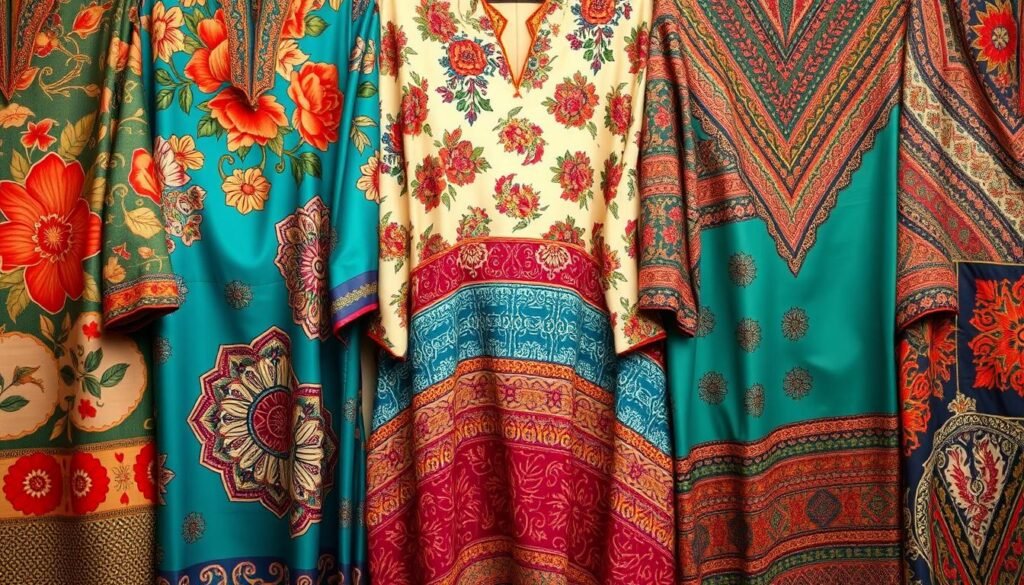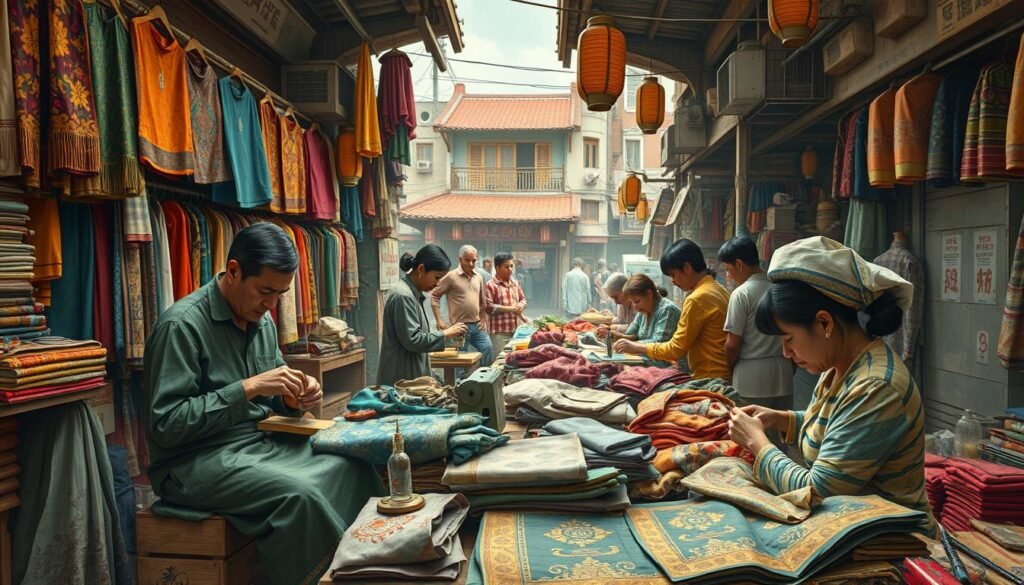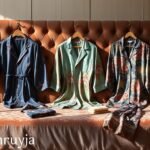Did you know that over 20 million people enjoy books and videos on fashion trends? The demand for custom silk clothes is growing fast. People want clothes that show off their style and luxury. Tailored fits and unique designs are changing how we see our clothes.
AI helps 1,270 brands understand what customers want. This shift shows a move towards more custom and sustainable fashion. For example, Tianruiyi offers high-quality silk pajamas that are both elegant and eco-friendly.
It’s important to keep up with these trends for both buyers and makers. Silk customization is now a big part of luxury fashion. It looks like the future of clothes will be all about unique, made-for-you pieces.
Key Takeaways
- Luxury silk garments are increasingly personalized to reflect individual styles.
- Sustainable materials are becoming a priority in the fashion industry.
- AI tools are transforming trend reporting and customization processes.
- Consumer interest in customized silk clothing continues to grow.
- Classic styles, such as the silk slip dress, embody elegance and versatility.
- Brands like Tianruiyi are setting the standard for high-quality silk customization.
- Understanding consumer preferences is key for success in the silk market.
The Growing Demand for Silk Clothing
The global silk clothing market is changing fast. More people want luxury fabrics. This trend looks good for the industry’s future.
Now, people care more about sustainable and quality materials. Silk is becoming key in today’s fashion.
Market Growth Projections
In 2020, the silk clothing market was worth USD 432.65 million. By 2030, it’s expected to hit USD 771.62 million. This is a growth rate of 8.30% from 2023 to 2030.
Several factors are driving this growth:
- Silk is used in many clothes like shirts and dresses. It’s versatile.
- More people want eco-friendly silk. This matches their values.
- New tech makes silk clothes better and more efficient.
Consumer Preferences for Luxury Fabrics
People now want more than just style in their clothes. They look for quality and sustainability. Silk meets these needs well.
It offers many options for unique clothes. This makes it popular among those who want something special.
Manufacturers are working hard to keep up. They’re making new products and forming partnerships. This ensures they meet what customers want.
As the silk market grows, businesses need to listen to what people want. This is key to success in this field.
| Year | Market Value (USD Million) | CAGR (%) |
|---|---|---|
| 2020 | 432.65 | N/A |
| 2023 (Projected) | Estimated Growth | 8.30 |
| 2030 (Projected) | 771.62 | 8.30 |
Customization Trends in Silk Clothing
Silk clothing customization has changed how we show our fashion style. Now, people can make their own designs, creating unique outfits. This shows how important personal touches are in today’s fashion world.
Personalization for Unique Wardrobes
More people want silk clothes that reflect their own style. They can choose custom designs and made-to-order services. This lets them show off their unique fashion sense.
Brands are catching on and giving more options. This encourages people to be creative with their outfits.
Influence of Social Media on Style Choices
Social media shapes what we like and how we dress. Sites like Instagram and TikTok show off custom silk clothes. This gets people excited and wanting to try new looks.
Seeing these styles online makes us want to follow them. It boosts sales and inspires us to make our own fashion statements.
Technology’s Role in Custom Silk Production
Technology has changed the fashion world, making silk production better. Artificial intelligence and blockchain technology help make clothes more personal and transparent. These changes meet what people want: quality, eco-friendly, and unique silk items.
Artificial Intelligence in Customization Processes
Artificial intelligence changes how we customize clothes. It uses data to create designs just for you. Brands like Zara use AI to spot trends and predict what’s next.
Retailers like Stitch Fix and Sephora use AI for personalized advice. This makes shopping better and boosts sales. Designers and customers work together online, making each piece special. This tech makes fitting easier and helps the environment.
Blockchain for Authenticity and Supply Chain Transparency
Blockchain is key for clear silk supply chains. It checks if products are real and made right. This makes customers trust brands more.
As brands focus on being green, blockchain helps. It ensures products are made responsibly. This supports the industry’s growth and keeps it sustainable.
Sustainable Practices in Silk Clothing Customization
In recent years, the silk clothing industry has seen a big change. More brands are now using eco-friendly silk and better production methods. This change shows they care about the planet and want to be open and fair in how they make things.
Eco-Friendly Sourcing of Silk
Brands like Seek Collective and HERTH are leading the way in using silk in a green way. Seek Collective uses natural dyes and makes sure there’s no waste. HERTH makes sure things are made right by getting certified for being green and fair.
Lotus silk is also becoming popular because it uses less water and can break down easily. This makes it a great choice for people who care about the planet.
Benefits of Sustainable Silk Fabrics
Sustainable fabrics do more than just help the planet. They also last longer and feel luxurious, which is great for those who care about the environment. Brands that focus on being green get more loyal customers and stand out more.
In 2024, we’ll see even more green choices like biodegradable fabrics and Tencel. The industry is moving towards making silk in a way that’s better for the planet. New tech like digital printing will help use less dye and water, making things more efficient.
| Brand | Key Sustainable Practices |
|---|---|
| Seek Collective | Zero-waste process, low-impact dyes, biodegradable materials |
| HERTH | GOTS certification, ethical design and packaging, slow fashion |
| The Ethical Silk Company | Focus on ethical labor practices, transparency, and minimal environmental impact |
| Indiebride | Commitment to sustainable fabrics, reduced carbon footprint |
| OZMA | Utilizes organic materials, promotes local production |
Popular Customization Techniques for Silk Garments
Customizing silk garments is key to making unique, personalized items. The rise in demand for personalized silk has led to many techniques. These methods improve both the look and function of these garments. This section explores some top silk techniques, like embroidery and special dyeing, that are popular today.
Embroidery and Personalized Monograms
Embroidery is a beloved technique for silk garments, adding elegance. Many people choose personalized silk with detailed embroidery or monograms. This makes the piece truly unique and special.
It not only makes the garment look better but also gives it a personal touch. Whether it’s a simple monogram or detailed floral patterns, embroidery highlights silk’s luxury.
Unique Dyeing Techniques for Custom Looks
Unique dyeing techniques also play a big role in custom silk designs. Methods like tie-dye and shibori make bold, eye-catching patterns. These patterns let people show off their personality through color and texture.
These dye options are great because they make each piece one-of-a-kind. Combining creative dyeing with silk’s softness creates garments that stand out. They meet today’s desire for personal expression.
The Influence of Cultural Elements in Silk Customization
Cultural influences are key in silk clothing customization. Brands use traditional designs to connect with those who value authenticity. This approach makes each piece unique and tells a special story.
Incorporating Traditional Designs and Patterns
Silk customization draws from history and local art. It appeals to fashion lovers who seek unique, handcrafted items. The detailed work in these garments shows the beauty of cultures worldwide.

| Cultural Influence | Examples in Silk Customization | Impact on Consumer Preferences |
|---|---|---|
| Asian Traditions | Incorporation of mandala patterns and floral motifs | Increased demand for bespoke silk pieces reflecting heritage |
| Middle Eastern Artistry | Use of geometric designs and vibrant color palettes | Enhanced appreciation for intricacy in luxury items |
| Global Fusion | Mixing cultural motifs from diverse regions | Appealing to a broad audience seeking unique and inclusive designs |
By focusing on traditional designs, silk items become more than just clothes. They connect people to their cultural roots. This appreciation for craftsmanship makes each piece a symbol of heritage.
Changing Demographics: Who is Customizing Silk Clothing?
The silk clothing market is changing, with new groups leading the way in customization. Millennials and Gen Z are at the forefront, valuing individuality and ethical choices in fashion. They want clothes that show who they are and are good for the planet.
Millennials and Gen Z Leading the Customization Movement
These young people love unique, personalized clothes. They shop online a lot, which boosts demand for custom silk. They want clothes that reflect their style and are made in a way that’s kind to the environment.
Inclusivity in Custom Silk Options for All Ages
There’s a big push for fashion that includes everyone. Brands are making silk clothes in all sizes and styles. This means everyone, from young to old, can find something that fits their taste and body.
Retailers Embracing Custom Silk Offerings
Retailers are now focusing on custom silk clothing to meet the growing demand for unique items. Successful brands are using online platforms to offer personalized shopping experiences. This approach helps them connect with consumers in a meaningful way.
Case Studies of Successful Custom Silk Brands
Many brands are leading in custom silk offerings, building strong connections with their customers. They have created user-friendly websites for customers to design their own silk garments. This trend is seen in customized saree designs, with more people wanting unique apparel.
The rise of bespoke wedding sarees shows this shift. Brides now want designs that show their individuality. Brands focusing on these unique pieces are growing in popularity.
How Retailers are Adapting to Consumer Needs
Retailers are changing in several ways:
- Investing in online platforms for easy silk garment customization
- Adding eco-friendly materials to their offerings
- Using social media to engage with customers
- Implementing AI tools for better customization
This shift shows a broader change in consumer behavior. More people want personalized shopping experiences. Brands that understand this are building loyalty and growing in the silk clothing market.
| Brand Name | Customization Feature | Consumer Response |
|---|---|---|
| Brand A | Online customization tool for silk sarees | Increased sales by 30% in six months |
| Brand B | Bespoke wedding silk garments | High demand with 80% pre-orders sold out |
| Brand C | Personalized silk scarves with monogram options | Boosted customer engagement and repeat purchases |
The Economic Impact of Silk Clothing Customization
The silk customization market is booming, thanks to people wanting personalized luxury clothes. This trend is making the market grow, opening up big opportunities for investors and businesses.
Market Statistics and Financial Projections
The global Mulberry Silk Market was worth USD 6.06 billion. It’s expected to hit USD 10.59 billion by 2030. This growth shows a 8.3% increase from 2024 to 2030, thanks to more demand for silk in textiles.
The silk market size was USD 20.91 billion in 2023. It’s set to grow to USD 35.63 billion by 2031. This supports the economic benefits of custom silk clothing.
Investment Opportunities in the Custom Silk Industry
There are many chances to invest in the silk customization sector. Global firms see the Indian market as very promising. The move towards sustainable and ethical silk production is attracting investors.
Companies that focus on sustainable fibers are drawing in more capital. They also meet consumer demand for organic and cruelty-free textiles. By cutting costs through marketing and retailing, businesses can grow and make more money.
As more people learn about sustainable fibers, the demand for quality silk will keep rising. This creates a great chance for investors to make money from high-quality silk products.

Combining Comfort and Style in Custom Silk Clothing
This section looks at how custom silk clothing mixes comfort and style. People love silk athleisure for its luxury and practical design. It’s perfect for those who want to upgrade their daily outfits with silk’s amazing qualities.
Trends in Silk Athleisure Wear
Silk athleisure has changed the fashion world. Now, everyone wants versatile silk clothing for both casual and formal events. For example, silk joggers with a silk top make a stylish outfit for any occasion.
Versatile Silk Pieces for Everyday Wear
Designers aim to make silk items that fit into everyday life. Silk slip midi dresses are a hit for their comfort and elegance. Brands like Tianruiyi offer custom pieces that are both stylish and comfortable.
Many customers also look for eco-friendly options. Brands are now using organic peace silk, showing they care about the planet. This means custom silk clothes are not just stylish but also good for the environment.
Challenges in the Custom Silk Clothing Market
The custom silk clothing market faces many hurdles. Supply chain problems and finding quality materials are big concerns. These issues affect how long it takes to make clothes and how much they cost.
Not being able to find good materials can lead to using fake ones. This takes away from what makes silk special.
Supply Chain Issues and Material Sourcing
Supply chain problems are a big deal in the custom silk clothing market. Most silk comes from countries like China and India. Any issues there can affect everyone else.
Things like labor shortages and environmental problems can cause big delays. Trade rules and taxes also make it hard to get silk into the country.
These problems can make silk clothes more expensive. It’s hard to keep making them the old way. Finding good materials is key to keeping costs down and quality up.
Consumer Education on Silk Care and Maintenance
Teaching people how to take care of silk is also important. Many don’t know how to handle their silk clothes. This can lead to damage.
It’s important to teach people about gentle washing and ironing. They should also know how to store silk clothes right. This helps keep the clothes looking good for a long time.
By teaching customers how to care for their silk, brands can help them enjoy their clothes more. This can also mean fewer returns and happier customers.
| Challenges in Silk Market | Description |
|---|---|
| Supply Chain Disruptions | Impact of labor shortages and environmental factors on production. |
| Material Sourcing | Difficulty in securing high-quality silk materials affects cost and quality. |
| Lack of Consumer Knowledge | Insufficient understanding of silk care leads to potentially damaging the fabric. |
| Trade Barriers | Tariffs and regulations complicate the importation of silk products. |
Conclusion
The world of silk clothing customization shows a big change in culture. People want to express themselves, care for the planet, and use new tech. This shift is making the silk market grow fast.
Custom clothes are special because they fit perfectly and use top-quality materials like silk. Ready-made clothes are quick but can’t match the personal touch of custom pieces. As more people want unique, high-end clothes, designers and brands need to keep up.
The mix of creativity, tech, and eco-friendliness in silk clothes is changing fashion. By focusing on these areas, brands can connect better with customers. This leads to a bright future for silk fashion trends.
FAQ
What drives the growing demand for silk clothing?
People want silk because it’s luxurious and good for the planet. As more learn about eco-friendly materials, they choose silk. It’s both fancy and made in a way that’s kind to the environment.
How is customization shaping the silk clothing market?
Customization is changing the silk market. It lets people make clothes that show off their style. Now, everyone can find clothes that fit their unique taste.
What role does technology play in silk custom production?
Tech is key in making custom silk clothes. AI helps make designs based on what people like. Blockchain makes sure the silk is real and comes from good places, building trust with buyers.
What are the benefits of sustainable silk fabrics?
Sustainable silk is good for the planet and looks great. It’s made in ways that care for the environment. This makes the clothes last longer and looks even better, which is good for brands.
What are some popular techniques for customizing silk garments?
People like to add embroidery or monograms to silk. They also use cool dyeing methods like tie-dye. These make clothes special and show off who they are.
How do cultural influences affect silk customization?
Culture plays a big part in silk designs. Brands use traditional patterns that connect with people’s roots. This makes clothes more meaningful and authentic.
Which demographics are driving silk clothing customization trends?
Younger people, like Millennials and Gen Z, are leading the way. They want clothes that show who they are, are good for the planet, and are made right. This means more demand for silk that fits their style.
How are retailers responding to the demand for customized silk clothing?
Stores are now focusing on making silk clothes just for you. They use online tools and personal service to meet what customers want. This helps keep customers happy and coming back.
What is the economic impact of the custom silk clothing market?
The custom silk market is big and getting bigger. It’s creating jobs and making money. Investors see the chance to make more money as more people want unique silk clothes.
What challenges does the custom silk clothing market face?
The market has to deal with finding materials and making sure they’re good. It’s also important to teach people how to take care of their silk clothes. This keeps them looking good for a long time.




